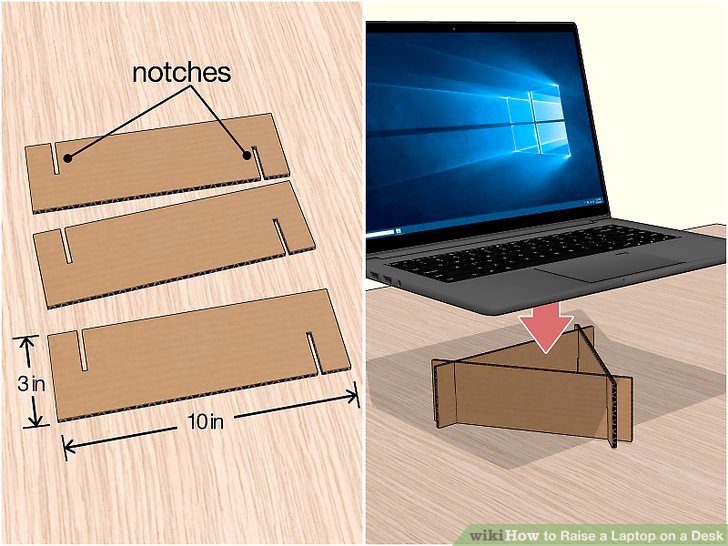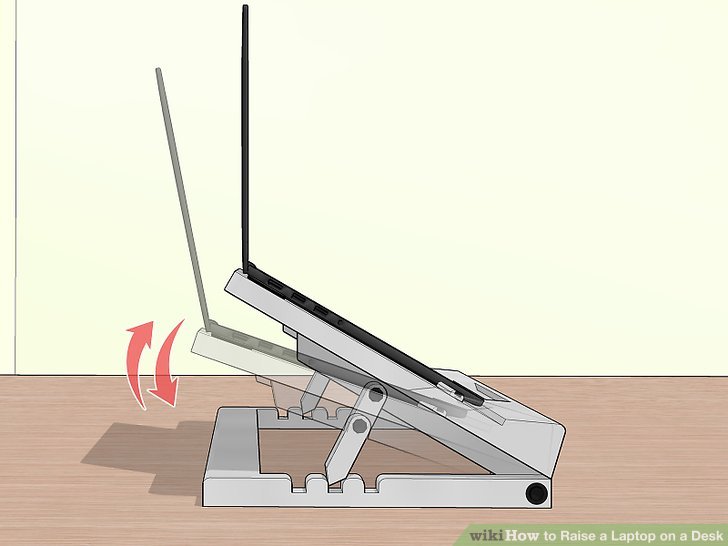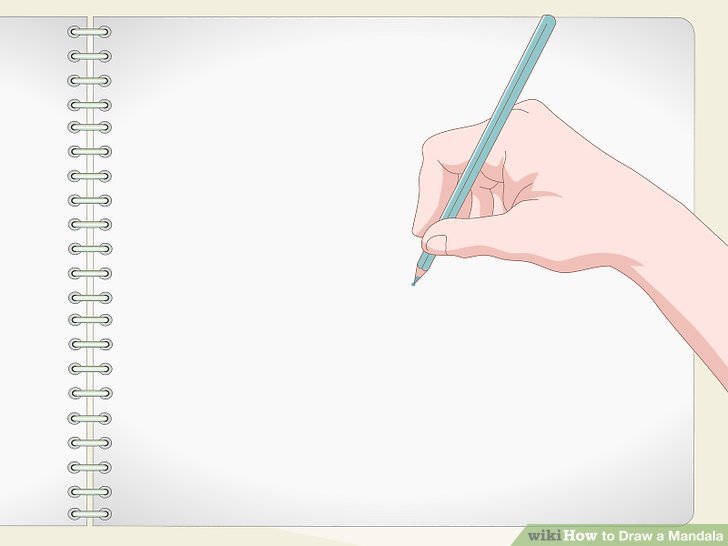If your laptop tends to overheat or you find your back and neck getting sore after using the laptop for a while, the problem may be that your laptop is sitting flat. When a laptop rests flat against a desk, the excess heat can build up inside of the computer, which can fry your hard drive or reduce the lifespan of the laptop. If you’re getting sore, it may be because you’re leaning forward or back to view your screen at a downward angle. Luckily, there are plenty of cheap and simple solutions to raising your laptop off of your desk.
Steps
Crafting a DIY Solution
- Prop the laptop up with books around the sides to reduce heat. Grab stack of 2-4 books that are equally thick. Slide the spine of a book under the right side of the laptop. Do the same on the left side of the laptop. If you want to stabilize the laptop further, you can slide another book under the back or the front of the laptop.[1]
- This will create some space between the bottom of the laptop and the surface it’s resting on. This space will make it easier for the heat to dissipate from the base of the laptop when it gets hot.
- You can really do this with a stack of any stable objects that are equally thick. For example, you could use stacks of coasters, hard plastic cases, Legos, or pieces of wood.
- If you want a cleaner look, cut 6-10 wine corks in half and set them under the laptop with the flat sides facing down.
- Slide a book behind the back of the laptop to improve the angle. If you want to improve your ergonomic situation, take a long, solid book and slide the spine underneath the back of the laptop. Continue sliding the book toward the front of the laptop until the laptop screen is elevated and easier for you to look at.
- If you slide the book too far forward, your laptop may slide off. You can put a heavy book in front of the laptop to hold it in place, but this can kind of be awkward to do.
- If you have pads on the bottom of the laptop to protect the surface underneath, put the spine just in front of these pads so the computer catches on the lip of the book.
- Like the cooling solution, you can use basically anything that will prop the laptop up . Wine corks, lids, wood objects, and plastic cases can all be slid under the back of the laptop to change the angle of the screen.
- Build a small platform out of corrugated cardboard. Grab a sheet of corrugated cardboard and cut it into 3 strips that are roughly thick and long. Either glue or staple the pieces together in a triangle, or cut notches into each piece where they layer over one another in a triangle and slide them together. Set the laptop on top of the triangle. Unless your laptop is really big or heavy, it should rest fine on top of the cardboard.[2]
- You can also get a unused pizza box and set the laptop on top of the box with the corners sticking out of the sides.
- Set the laptop on a taller object to get it eye level and use a second keyboard. If you want to elevate the laptop to avoid neck strain, set it down on top of a small box, platform, or shelf that rests at eye level. Then, plug in an external keyboard and mouse to the USB ports on the laptop. You can control the laptop from the table or desk underneath while looking ahead at an appropriate angle.[3]
Buying a Laptop Stand
- Get a cooling stand with a built in fan to keep the laptop cool. If you’re having trouble with your laptop overheating, buy a laptop stand with a built-in fan or cooling pad. Set the laptop on top of the stand and plug the fan into an outlet or USB port to turn it on. The fan or cooling pad will activate and keep the heat from building up in your laptop.[4]
- Some of these stands run on batteries and have a power button, usually on the side or the base.
- All laptop stands will cost roughly $10-20 depending on the features and brand you want to buy. The only exception are standing platforms.
- Laptop stands are not universal, so you need to make sure that the laptop stand fits the size and brand of your computer before purchasing it.
- Get an adjustable laptop stand to control the angle and height. If you want more control over the height and angle of the laptop, get an adjustable stand. Before putting your laptop on the stand, use the knob or lever to adjust the angle and height. Then, set your laptop on top of the platform so that the base catches on the lip at the bottom of the platform.[5]
- Some adjustable stands are known for being less stable than non-adjustable versions. Look at reviews and inspect the product in person if you can. This will give you a better sense of how stable the stand is.
- Making adjustments on these stands is usually pretty intuitive, but every stand has a different design which can make figuring it out the first time kind of tricky. There’s usually a knob or dial on the back or side that you turn to raise the stand or change the angle. Some stands unlock when you flip a lever allowing you to make adjustments by hand.
- Use a standing platform if you want a DIY standing desk. If you want to customize the height of your laptop, get a standing platform stand. These stands are basically small desks with legs that raise or lower. Some of them allow you to change the angle of the laptop as well. This makes them a great option if you like to occasionally stand while you’re using your laptop.[6]
- These standing platforms are often marketed as adjustable mini-desks or adjustable stands.
- Standing platforms are the most expensive option since they offer so much customization. They can cost anywhere from $20-50 depending on the style and options you want.
- Purchase a wood laptop stand for a sleeker, cleaner option. Wood stands tend to look really sleek and elegant compared to their plastic and metal counterparts. If you care about the way your laptop stand looks on your desk, get a sleek wood stand with a grain and color that matches the rest of the room. Simply place the laptop on top with the bottom of the laptop resting against the lip at the bottom.[7]
Tips
- Ergonomically speaking, the ideal height for a computer screen is slightly below eye-level. This will prevent neck and back strain.[8]
- It’s technically not good for your wrists if your keyboard is sitting up an angle. For some people an elevated keyboard makes it easier to type, though. It’s fine to elevate your keyboard so long as you don’t experience wrist pain.[9]
- There are vents on the side of your laptop, but there are also vents underneath in all likelihood. When the computer isn’t working particularly hard, the vents on the side are more than enough to expel heat. Unfortunately, if the bottom is covered and you’re doing something intensive on the computer, the vents on the side may not be enough.[10]
References
- ↑ https://www.spine-health.com/blog/10-best-ergonomic-laptop-setup-tips
- ↑ http://theclosetentrepreneur.com/the-diy-cheapskate-laptop-stand
- ↑ https://www.cnet.com/how-to/how-to-improve-laptop-posture-ergonomics/
- ↑ https://www.laptopmag.com/articles/best-laptop-stands
- ↑ https://www.laptopmag.com/articles/best-laptop-stands
- ↑ https://www.laptopmag.com/articles/best-laptop-stands
- ↑ https://www.laptopmag.com/articles/best-laptop-stands
- ↑ http://ergo.human.cornell.edu/AHTutorials/typingposture.html
- ↑ https://www.onhealth.com/content/1/ergonomics_keyboard_and_mouse_setup_computer
- ↑ https://www.forbes.com/sites/rahilbhagat/2016/07/31/do-you-really-need-a-laptop-cooler/#3507f4af5e1b












Thank you for your sharing. I am worried that I lack creative ideas. It is your article that makes me full of hope. Thank you. But, I have a question, can you help me?
en uygun fiyatlardan heets satın alın ve sizde heets sigara sahibi olun
sizde hemen kuşadası escort hizmetinden faydalanın ve hızlı şekilde escort bayan çağırın